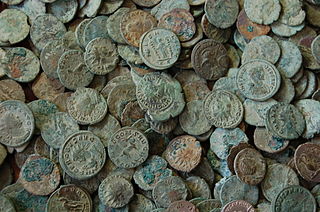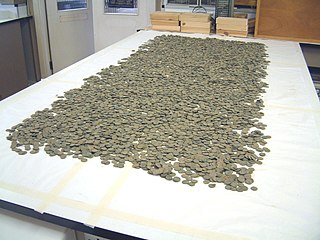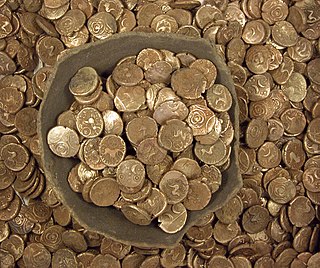 W
WThe Beau Street Hoard, found in Bath, Somerset, is the fifth-largest hoard ever found in Britain and the largest ever discovered in a British Roman town. It consists of an estimated 17,500 silver Roman coins dating from between 32 BC and 274 AD. The hoard was found on Beau Street about 150 metres (490 ft) from the town's Roman Baths, built when Bath was a Roman colony known as Aquae Sulis.
 W
WThe Binnington Carr Hoard is a Roman coin hoard dating from the late 1st century AD. It contains 12 silver denarii within a copper alloy bell. It is in the collection of the Yorkshire Museum.
 W
WThe Boston Spa hoard is a Romano-British hoard of 172 coins in a ceramic vessel found near Boston Spa in 1848.
 W
WThe Bredon Hill Hoard is a hoard of 3,784 debased silver Roman coins discovered in June 2011 by two metal detectorists on Bredon Hill in Worcestershire, approximately 400 metres north of Kemerton Camp, an Iron Age hill fort. The coins were found in a clay pot that had been buried around the middle of the 4th century in a Roman villa, identified by the subsequent archaeological excavation. The coins include the reigns of sixteen different emperors during the mid to late 3rd century, and are the largest hoard of Roman coins to have been discovered in Worcestershire to date.
 W
WThe Canterbury Treasure is an important late Roman silver hoard found in the city of Canterbury, Kent, south-east England in 1962, and now in the Roman Museum, Canterbury, Kent. Copies of the main items are also kept in the British Museum.
 W
WThe Capheaton Treasure is an important Roman silver hoard found in the village of Capheaton in Northumberland, north-east England. Since 1824, it has been part of the British Museum's collection.
 W
WThe Corbridge Hoard is a hoard of mostly iron artefacts that was excavated in 1964 within the Roman site of Coria, next to what is now Corbridge, Northumberland, England.
 W
WThe Fremington Hagg Hoard is a hoard of Roman horse harness fittings found in Fremington Hagg, near Reeth, North Yorkshire in the early 19th Century. Parts of it are in the collections of the British Museum and the Yorkshire Museum.
 W
WThe Frome Hoard is a hoard of 52,503 Roman coins found in April 2010 by metal detectorist Dave Crisp near Frome in Somerset, England. The coins were contained in a ceramic pot 45 cm (18 in) in diameter, and date from AD 253 to 305. Most of the coins are made from debased silver or bronze. The hoard is one of the largest ever found in Britain, and is also important as it contains the largest group ever found of coins issued during the reign of Carausius, who ruled Britain independently from 286 to 293 and was the first Roman Emperor to strike coins in Britain. The Museum of Somerset in Taunton, using a grant from the National Heritage Memorial Fund (NHMF), acquired the hoard in 2011 for a value of £320,250.
 W
WThe Heslington Hoard is a coin hoard found in York, England, dating from the mid-4th century AD. It consisted of approximately 2,800 coins held within a pottery container. It was acquired by the Yorkshire Museum.
 W
WThe Hoxne Hoard is the largest hoard of late Roman silver and gold discovered in Britain, and the largest collection of gold and silver coins of the fourth and fifth centuries found anywhere within the Roman Empire. It was found by Eric Lawes, a metal detectorist in the village of Hoxne in Suffolk, England in 1992. The hoard consists of 14,865 Roman gold, silver, and bronze coins and approximately 200 items of silver tableware and gold jewellery. The objects are now in the British Museum in London, where the most important pieces and a selection of the rest are on permanent display. In 1993, the Treasure Valuation Committee valued the hoard at £1.75 million.
 W
WThe Knaresborough Hoard is a hoard of Romano-British metalwork from near Knaresborough, North Yorkshire. It is the largest hoard of Romano-British copper-alloy vessels discovered to date in Britain. A partial catalogue of the hoard was published by Eggers in 1966. Between 2019 and 2021 it was studied as part of the Knaresborough and Irchester Roman Hoards Project (KNIROH) at Newcastle University.
 W
WThe Mildenhall Treasure is a large hoard of 34 masterpieces of Roman silver tableware from the fourth century AD, and by far the most valuable Roman objects artistically and by weight of bullion in Britain. It was found at West Row, near Mildenhall, Suffolk, in 1942. It consists of over thirty items and includes the Great Dish which weighs over 8kg.
 W
WThe Overton Hoard is a Roman coin hoard dating from the early 3rd century AD. It contains 37 coins and fragments of a pottery container. It was acquired by the Yorkshire Museum in 2018.
 W
WThe Ribchester Helmet is a Roman bronze ceremonial helmet dating to between the late 1st and early 2nd centuries AD, which is now on display at the British Museum. It was found in Ribchester, Lancashire, England in 1796, as part of the Ribchester Hoard. The model of a sphinx that was believed to attach to the helmet was lost.
 W
WThe Shapwick Hoard is a hoard of 9,262 Roman coins found at Shapwick, Somerset, England in September 1998. The coins dated from as early as 31–30 BC up until 224 AD. The hoard also notably contained two rare coins which had not been discovered in Britain before, and the largest number of silver denarii ever found in Britain.
 W
WThe Shrewsbury Hoard is a hoard of 9,315 bronze Roman coins discovered by a metal detectorist in a field near Shrewsbury, Shropshire in August 2009. The coins were found in a large pottery storage jar that was buried in about AD 335.
 W
WThe Snettisham Jeweller's Hoard is a collection of Romano-British jewellery and raw materials, found during the construction of a house in the Norfolk village of Snettisham in 1985. The hoard is thought to be the working stock of a jeweller, buried in a single clay pot around 155 AD. The finds include the working tip of a quartz burnishing tool, partially or fully completed items of jewellery, and raw materials: mainly silver coins, scrap silver items and silver ingots, but also six pieces of scrap gold, and many engraved gemstones to be set in rings. The presence of scrap gold and silver and absence of base metals indicates that the jeweller dealt mainly with high-status customers.
 W
WThe St Albans Hoard is a large hoard of late Roman gold coins found by a metal detectorist in a field near St Albans, Hertfordshire, England in 2012. It is believed to be one of the largest hoards of Roman gold coins ever found in Britain. The hoard consists of 159 solidi dating from the last decades of the fourth century AD, near the end of the Roman occupation of Britain. After about 408, new Roman coins ceased to circulate in Britain, causing the collapse of the monetary economy and of mass-production industry.
 W
WThe Thetford Hoard is a hoard of Romano-British metalwork found by Arthur and Greta Brooks at Gallows Hill, near Thetford in Norfolk, England, in November 1979, and now in the British Museum. Dating from the mid- to late-4th century AD, this hoard is a collection of thirty-three silver spoons and three silver strainers, twenty-two gold finger rings, four gold bracelets, four necklace pendants, five gold chain necklaces and two pairs of necklace-clasps, a gold amulet designed as a pendant, an unmounted engraved gem, four beads, and a gold belt-buckle decorated with a dancing satyr. A small cylindrical lidded box made from shale also belonged to the hoard.
 W
WThe Thornbury Hoard is a hoard of 11,460 copper alloy Roman coins, mainly radiates and nummi, dating from 260 to 348, found in the back garden of Ken Allen in Thornbury, South Gloucestershire, England while digging a pond in March 2004. It was described as the "third largest of its kind" found in Great Britain.
 W
WThe Upchurch Hoard was a pot containing thirty-seven Roman sestertii dating from the late 1st century to the second half of the 2nd century AD found near the village of Upchurch, Kent, England, in 1950.
 W
WThe Water Newton Treasure is a hoard of fourth-century Roman silver, discovered near the location of the Roman town of Durobrivae at Water Newton in the English county of Cambridgeshire in 1975. The hoard consisted of 27 silver items and one small gold plaque. Because of inscriptions found on some of the pieces in the collection it has been suggested that they may have been used in a local church, and they therefore comprise the earliest probable group of Christian liturgical silver yet found in the Roman Empire.
 W
WThe West Bagborough Hoard is a hoard of 670 Roman coins and 72 pieces of hacksilver found in October 2001 by metal detectorist James Hawkesworth near West Bagborough in Somerset, England.
 W
WThe Wickham Market Hoard is a hoard of 840 Iron Age gold staters found in a field at Dallinghoo near Wickham Market, Suffolk, England in March 2008 by car mechanic, Michael Dark using a metal detector. After excavation of the site, a total of 825 coins were found, and by the time the hoard was declared treasure trove, 840 coins had been discovered. The coins date from 40 BC to 15 AD.
 W
WThe Wold Newton Hoard is a coin hoard dating from the early 4th century AD. It contains 1,857 coins held within a pottery container. It was acquired by the Yorkshire Museum in 2016.